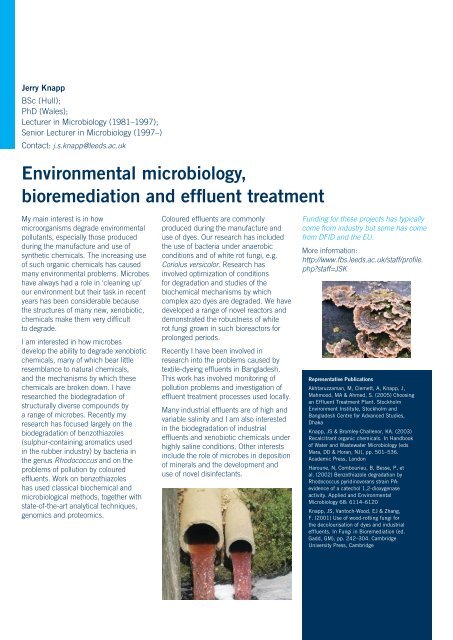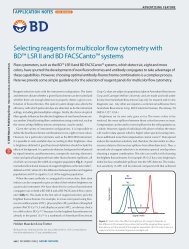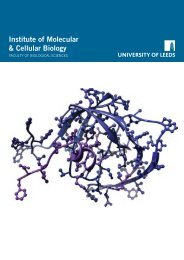3649-08 IICB.indd - Faculty of Biological Sciences - University of ...
3649-08 IICB.indd - Faculty of Biological Sciences - University of ...
3649-08 IICB.indd - Faculty of Biological Sciences - University of ...
You also want an ePaper? Increase the reach of your titles
YUMPU automatically turns print PDFs into web optimized ePapers that Google loves.
Jerry Knapp<br />
BSc (Hull);<br />
PhD (Wales);<br />
Lecturer in Microbiology (1981–1997);<br />
Senior Lecturer in Microbiology (1997–)<br />
Contact: j.s.knapp@leeds.ac.uk<br />
Environmental microbiology,<br />
bioremediation and effluent treatment<br />
My main interest is in how<br />
microorganisms degrade environmental<br />
pollutants, especially those produced<br />
during the manufacture and use <strong>of</strong><br />
synthetic chemicals. The increasing use<br />
<strong>of</strong> such organic chemicals has caused<br />
many environmental problems. Microbes<br />
have always had a role in ‘cleaning up’<br />
our environment but their task in recent<br />
years has been considerable because<br />
the structures <strong>of</strong> many new, xenobiotic,<br />
chemicals make them very difficult<br />
to degrade.<br />
I am interested in how microbes<br />
develop the ability to degrade xenobiotic<br />
chemicals, many <strong>of</strong> which bear little<br />
resemblance to natural chemicals,<br />
and the mechanisms by which these<br />
chemicals are broken down. I have<br />
researched the biodegradation <strong>of</strong><br />
structurally diverse compounds by<br />
a range <strong>of</strong> microbes. Recently my<br />
research has focused largely on the<br />
biodegradation <strong>of</strong> benzothiazoles<br />
(sulphur-containing aromatics used<br />
in the rubber industry) by bacteria in<br />
the genus Rhodococcus and on the<br />
problems <strong>of</strong> pollution by coloured<br />
effluents. Work on benzothiazoles<br />
has used classical biochemical and<br />
microbiological methods, together with<br />
state-<strong>of</strong>-the-art analytical techniques,<br />
genomics and proteomics.<br />
Coloured effluents are commonly<br />
produced during the manufacture and<br />
use <strong>of</strong> dyes. Our research has included<br />
the use <strong>of</strong> bacteria under anaerobic<br />
conditions and <strong>of</strong> white rot fungi, e.g.<br />
Coriolus versicolor. Research has<br />
involved optimization <strong>of</strong> conditions<br />
for degradation and studies <strong>of</strong> the<br />
biochemical mechanisms by which<br />
complex azo dyes are degraded. We have<br />
developed a range <strong>of</strong> novel reactors and<br />
demonstrated the robustness <strong>of</strong> white<br />
rot fungi grown in such bioreactors for<br />
prolonged periods.<br />
Recently I have been involved in<br />
research into the problems caused by<br />
textile-dyeing effluents in Bangladesh.<br />
This work has involved monitoring <strong>of</strong><br />
pollution problems and investigation <strong>of</strong><br />
effluent treatment processes used locally.<br />
Many industrial effluents are <strong>of</strong> high and<br />
variable salinity and I am also interested<br />
in the biodegradation <strong>of</strong> industrial<br />
effluents and xenobiotic chemicals under<br />
highly saline conditions. Other interests<br />
include the role <strong>of</strong> microbes in deposition<br />
<strong>of</strong> minerals and the development and<br />
use <strong>of</strong> novel disinfectants.<br />
Funding for these projects has typically<br />
come from industry but some has come<br />
from DFID and the EU.<br />
More information:<br />
http://www.fbs.leeds.ac.uk/staff/pr<strong>of</strong>ile.<br />
php?staff=JSK<br />
Representative Publications<br />
Akhtaruzzaman, M, Clemett, A, Knapp, J,<br />
Mahmood, MA & Ahmed, S. (2005) Choosing<br />
an Effluent Treatment Plant. Stockholm<br />
Environment Institute, Stockholm and<br />
Bangladesh Centre for Advanced Studies,<br />
Dhaka<br />
Knapp, JS & Bromley-Challenor, KA. (2003)<br />
Recalcitrant organic chemicals. In Handbook<br />
<strong>of</strong> Water and Wastewater Microbiology (eds<br />
Mara, DD & Horan, NJ), pp. 501–536.<br />
Academic Press, London<br />
Haroune, N, Combourieu, B, Besse, P, et<br />
al. (2002) Benzothiazole degradation by<br />
Rhodococcus pyridinovorans strain PA:<br />
evidence <strong>of</strong> a catechol 1,2-dioxygenase<br />
activity. Applied and Environmental<br />
Microbiology 68: 6114–6120<br />
Knapp, JS, Vantoch-Wood, EJ & Zhang,<br />
F. (2001) Use <strong>of</strong> wood-rotting fungi for<br />
the decolourisation <strong>of</strong> dyes and industrial<br />
effluents. In Fungi in Bioremediation (ed.<br />
Gadd, GM), pp. 242–304. Cambridge<br />
<strong>University</strong> Press, Cambridge










